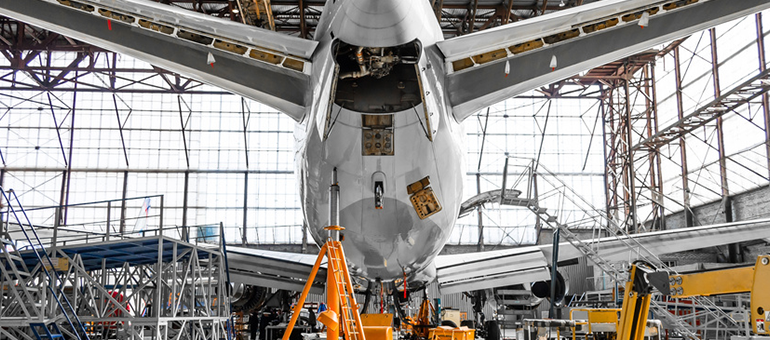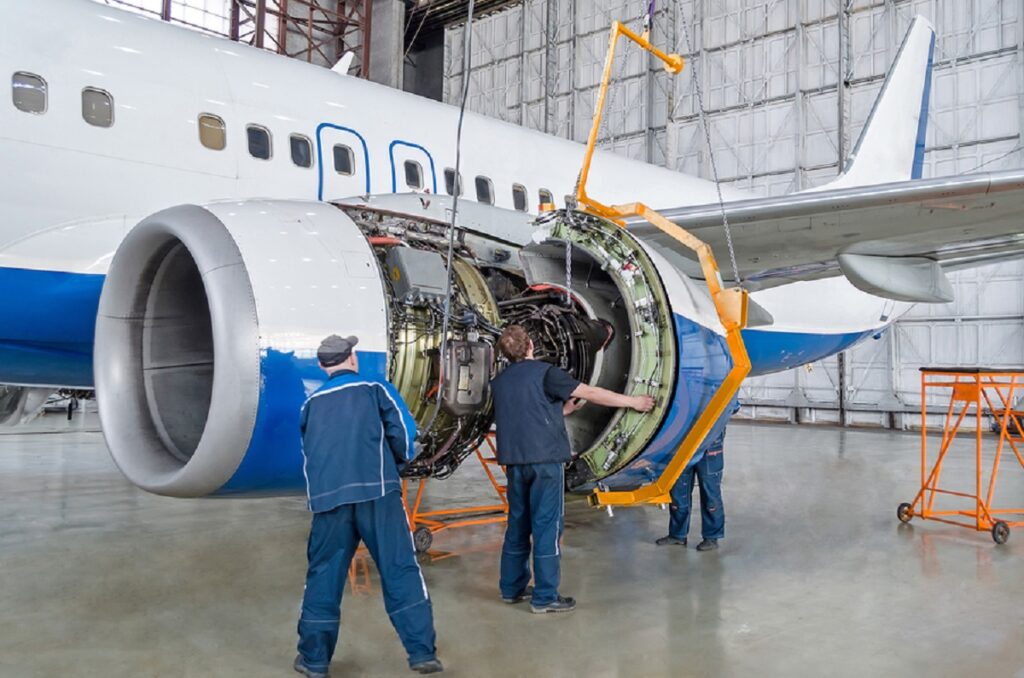
Aircraft Hangar Hazards: What Aviation Technicians Should Know
Protecting Planes of All Sizes
A typical modern aircraft hangar is a large, heavy-duty structure designed for the safe shelter, repair, and maintenance, as well as protective storage of aircraft. These unique buildings can be expected to have very high ceilings and huge, heavy-weight doors. Today’s hangars are critical for protecting planes of all sizes from the elements while ensuring convenient routine servicing and repairs.
Bigger and More Durable Facilities
The history of aircraft hangars dates back more than 100 years, coinciding with the introduction of powered human flight. The first of these structures were just basic wooden buildings, but as aviation and airplane designs advanced, so did the design and materials used in hangar construction. During World War I and II, the necessity for more robust and functional hangars became essential to the war efforts, leading to the creation of bigger and more durable facilities. Innovations forged a path that included the use of stronger steel and concrete, making way for wider wing spans and more versatile architectures.
Better Sustainability and Efficiency
Fast forward to today, where hangars can be seen in many different forms, from small and simple private structures at local airports to massive structures used by commercial airlines and the various military branches. In recent times, the emphasis has shifted to better sustainability and efficiency, with increasing numbers of new hangar construction projects incorporating green technologies, such as solar collection panels and innovative insulation intended to reduce overall environmental impact.
Urban Air Mobility and Drone Operations
Looking ahead, the multi-use aircraft hangar is expected to evolve even further. As the aviation world increasingly embraces electric powered and alternate-fuel aircraft, hangars will need to accommodate new technologies, including electrical charging systems and dedicated maintenance areas. In addition, the emergence of urban air mobility and drone activity may also influence upcoming hangar designs, requiring multi-functional spaces that will serve an array of aircraft types and designs.
Awareness and Safety Training
That said, from the older style hangars to the newest design concepts still on the horizon, safety and risk mitigation must always be the central theme. This is because these specialized structures present clearly identified hazards for both pilots and maintenance technicians, encompassing a range of risks and dangers, including chemicals to tools and the challenges of handling large aircraft. Awareness and safety training are the keys to reducing risk in these potentially dangerous aviation related workspaces.
The Nature of Hazards
Aviation maintenance and repair technicians can become complacent over time, which may lead to the underestimating of risks. For example, aviation workers may overlook the cumulative effects of workplace related radiation exposure from radar systems or caustic chemicals that have long-term health effects. Therefore, strict adherence to safety protocols while on the job and the use of personal protective equipment should always be standard practice.
Complacency and Urgency
Complacency is one of the most common and significant factors in hangar and aviation workplace accidents. Many incidents leading to injury will occur when airplane technicians are hurried or fail to follow established and accepted safety procedures. The pressure to complete a project in a hurried fashion may lead to dangerous shortcuts, underscoring the need for clear and concise communication and adherence to accepted practices and procedures during maintenance work.
Electrical Hazards
Electrical hazards pose very real challenges in modern aircraft hangars, as technicians may need to readily recognize the presence of high-voltage electricity in wires or equipment. Ensuring that an aircraft is fully powered down before conducting any work on avionics or electrical components is essential to preventing serious injuries or loss of life. Prior to the application of system power, connectors, and plugs should always be carefully inspected to avoid the potential for dangerous or life-threatening situations.
Physical Hazards inside The Hangar
The typical aircraft hangar environment is overwhelmed with potential physical hazards, such as heavy-duty power cables, tool carts, and toxic fluid spills. Safety protocols must include the routine grounding of an aircraft to prevent electrical hazards and limiting clutter to minimize any possible trip hazards. Specialized padding covering sharp edges and the careful management of cables will also help to prevent injury causing slips and falls.
Air Stair Doors on Aircraft
Another commonly overlooked hangar hazard involves the air stair doors on an aircraft, which can result in slips and falls, especially in wet weather. It is essential that aviation technicians always maintain good situational awareness in order to avoid these seemingly minor yet potentially hazardous situations.
Ergonomics and Injury Prevention
As the aviation workforce ages, the importance of good ergonomics in preventing injuries becomes even more of an issue. Techniques for safe and injury-free lifting and the regular use of kneepads can significantly reduce the dangers of back injuries in small and tight workspaces. Additionally, Kevlar gloves are vital in protecting technicians from cuts, while nitrile or latex gloves are highly protective when working around corrosive and toxic chemical.
Chemical Safety
Aviation technicians are regularly exposed to dangerous chemicals that can pose long-term health risks if not handled correctly. Mitigating the risks of exposure, such as unintended absorption through the skin and inhalation of toxic fumes, is crucial. Equally important is the proper use of appropriate protective equipment, including breathing masks whenever preforming various aviation maintenance type procedures.
Emergency Preparedness
Despite all the precautions outlined, accidents do still occur. Effective emergency response training is vital to an organization’s long-term success. Safety training provides ongoing education on the correct handling of hazardous materials, CPR, and medical first aid. The first few minutes following an accident or incident can be critical; as such, training employees to respond effectively will save lives.
Community Involvement in Safety Training
Fostering a culture of safety that extends beyond the workplace by involving aviation employees and their families in safety training sessions and conferences is an excellent safety improving strategy. These gatherings cover a host of safety topics that are designed to reduce risks and workplace dangers, reinforcing the importance of safety awareness.
Individual Responsibility
Safety in the hangar is clearly a personal responsibility. While employers can provide comprehensive training and safety equipment, it rests with each employee to actively engage in good safety practices. The effectiveness of established safety measures is the direct result of each aviation workers commitment to the proper application of equipment and training, while always following approved safety procedures.
Lightning Hazards
A sometimes-overlooked hazard is the potential for lightning strikes, which can be deadly to aviation technicians working on an aircraft ramp. Aviation workers are particularly at risk, especially during airplane pushbacks or maintenance operations on the ramp. The best practice is to immediately move indoors anytime there is lightning within a five-mile radius.
Conclusion
In summary, aircraft hangars and ramps are laden with hazards that require constant vigilance and a proactive approach to flightline safety. Ongoing education, adherence to proven safety protocols, and individual responsibility are keys to creating a safe aviation working environment. As the industry moves forward, promoting a “safety-first” culture that includes good workplace practices and community involvement, protecting aviation workers, and ensuring their safety in these high-risk aviation environments is always the goal.
About APN
Finding an aviation property or hangar home is simplified with help from APN (Aviation Property Network). The company has a staff of seasoned and experienced aviation real estate professionals that are ready to assist buyers and sellers.
With APN, you can list a property for sale, lease an aviation property, or rent overnight. The APN website features a growing international database of aviation real estate opportunities. From raw land to airport businesses and live-work style hangars, APN has all elements of aviation property investments under one roof.
Looking to buy or sell a hangar, move to an airpark community, buy or sell an FBO or even develop a new project? Work with the leader in world-wide aviation property transactions today! Contact APN NOW!
